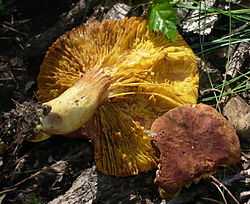Phylloporus pelletieri
| Phylloporus pelletieri | |
|---|---|
 | |
| Scientific classification | |
| Kingdom: | Fungi |
| Division: | Basidiomycota |
| Class: | Agaricomycetes |
| Order: | Boletales |
| Family: | Boletaceae |
| Genus: | Phylloporus |
| Species: | P. pelletieri |
| Binomial name | |
| Phylloporus pelletieri (Lév.) Quél. (1888) | |
| Synonyms[1] | |
|
Agaricus pelletieri Lév. (1867) | |
Phylloporus pelletieri, commonly known as the golden-gilled bolete, is a species of fungus in the Boletaceae family.
Taxonomy
The species was first described by French mycologist Joseph-Henri Léveillé in 1867 under the name Agaricus pelletieri.[2] Lucien Quélet transferred it to Phylloporus in 1888.[3]
Description
The underside of the its cap bears lamellae (gill-like structures) rather than the pores common in the Boletales. The reddish, domed cap is smooth with a velvety texture, while the lamellae are bright yellow.[4] The stem supporting the cap is also yellow with a red-brown veil.[5]
Habitat and distribution
The golden-gilled bolete forms mycorrhizal relationships with broadleaved trees such as beech and coniferous trees such as fir or pine.[6] The fruit bodies are produced in summer and autumn.[6]
Although rare, the golden-gilled bolete has a widespread distribution in Europe and reaches into Asia.[6] It inhabits broadleaf or coniferous forests in montane or sub-alpine regions, where it is associated with acidic or sandy soils.[6] This species is threatened by air pollution and forestry plantations, which can destroy its natural habitat.[6] It is short-listed for inclusion in Appendix I of the Convention on the Conservation of European Wildlife and Natural Habitats, otherwise known as the Bern Convention, by the European Council for Conservation of Fungi (ECCF), and included on the Red Lists of 12 European countries.[7] Other conservation recommendations include the mapping of existing sites and a reduction in air pollution, together with restrictions on forestry practice at known locations.[6]
References
This article incorporates text from the ARKive fact-file "Phylloporus pelletieri" under the Creative Commons Attribution-ShareAlike 3.0 Unported License and the GFDL.
- ↑ "Phylloporus pelletieri (Lév.) Quél. 1888". MycoBank. International Mycological Association. Retrieved 2011-08-03.
- ↑ Crouan PL, Crouan HM. (1867). Florule de Finistère, Contenant des Descriptions de 360 Espèces Nouvelles de Sporogames, des Nombreuses Observations (in French). p. 81.
- ↑ Quélet L. Flore mycologique de la France et des pays limitrophes (in French). p. 409.
- ↑ Pegler, D. & Spooner, B. (1992) The Mushroom Identifier. Apple Press, London.
- ↑ Fungi of Poland (July 2003).
- ↑ 6.0 6.1 6.2 6.3 6.4 6.5 European Council for Conservation of Fungi (ECCF) (2001) Datasheets of threatened mushrooms of Europe, candidates for listing in Appendix I of the Convention. Bern Convention Standing Committee.
- ↑ The distribution, status and habitat requirement of the 33 fungal candidates for listing in Appendix I of the Bern Convention (June 2003)
External links
- Phylloporus pelletieri media at ARKive
- Phylloporus pelletieri in Index Fungorum.